Re: {भारतीयविद्वत्परिषत्} Help request from scholars on two terms वर्ण - अक्षर
Raghavendra
<<My reason to seek this clarification:
a) Shikshaa shaastra ( apparently -?) speaks of : वर्ण-स्वर-मात्रा-बल-साम-सन्तान
b) Gita uses terms : वर्णाकृति - अक्षर-ब्रह्म - शब्द-ब्रह्म
C) We have terms like - ब्रह्माक्षर – अर्धाक्षर which carry special meaning.>>
I am providing the following input based on the above query of yours with special reference to the terms carrying special meanings.
श्रीमद्-आनन्दतीर्थ-भगवद्पादाचार्य gives the following etymological meanings of the terms वर्ण and अक्षर which is in line with his position of each and every sound in their primary sense speaking of the auspicious epithet of विष्णु, who is the Vedantic Brahman (ब्रह्मशब्दश्च विष्णावेव) in his thought.
◆वरणीयो वर्णः । स्वरतेस्तु स्वरः । मानात् त्राता मात्रा । बलरूपः । समश्च सर्वरूपेषु । सन्ततश्च ।
(तैत्तरियोपनिषद्भाष्य)
◆अधिकं क्षरतीत्यक्षरम् । क्षरणं नाम सन्ततदानम् । क्षर विनाशसन्ततदानयोः इति धातोः । एवमृषिषु शब्देषु च व्यवह्रियमाणानि सर्वाणि नामानि विष्णोरेव मुख्यतः । (महैतरेयोपनिषद्भाष्य)
◆अक्षयाद्रतिरूपत्वादक्षेषु रमणादपि । अक्षरं भगवान् विष्णुरोमित्युच्चत्वहेतुतः ॥ (छान्दोग्योपनिषद्भाष्य)
This is how the Achārya achieves sarva-shabda-vāchyatva in विष्णु from the point of view of his Vêdānta philosophy.
Thank you & Best regards,
Raghavendra. B
=============================From: "BVK Sastry (G-S-Pop)" <sastr...@gmail.com>
Sent: Mon, 4 Jul 2022 10:25:50 GMT+0530
To: <bvpar...@googlegroups.com>
Subject: {भारतीयविद्वत्परिषत्} Help request from scholars on two terms वर्ण - अक्षर
Namaste
I seek help from scholars in understanding the traditional perspective and distinctions between two technical terms noted below. The terms seem to occur in different contextual connotations, yet interconnected in with Samskruth Language studies and related Philosophy and Gita studies.
The two terms are : वर्ण - अक्षर
[ I do understand each ‘acharya’ invokes the technicality of Samskruth grammar contextually and differently; and I a mortal just trust their vision and wisdom.
I am confused on which of these terms clearly maps to the ‘understanding of ‘Alphabet – Characters’ as basic units in Samskruth Language computations and standards coding.
This clarity is not needed or debated for ‘Roman alphabet –character set ! So the quest here becomes specific and focused to Samskruth / Brahmi /Indic language computational linguistics. ]
My reason to seek this clarification:
a) Shikshaa shaastra ( apparently -?) speaks of : वर्ण-स्वर-मात्रा-बल-साम-सन्तान
b) Gita uses terms : वर्णाकृति - अक्षर-ब्रह्म - शब्द-ब्रह्म
C) We have terms like - ब्रह्माक्षर – अर्धाक्षर which carry special meaning.
d) Panini Shiva-sutras are called ‘वर्णाक्षर-समाम्नाय’ . The clarity on ‘technicality of varna and akshara’ is raised in Mahabhashya itself. The snippets below are to highlight the debate related to the distinction of Varna and Akshara.
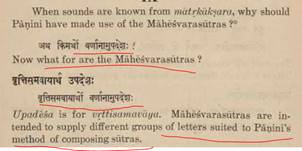


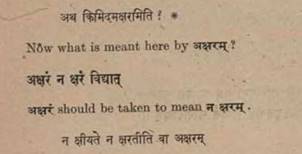
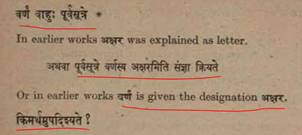
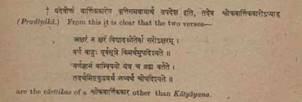
e) Other relevant snippets that seem to be connected with the above discussion.
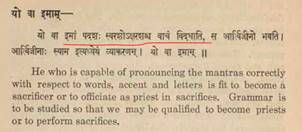

Regards
BVK Sastry
You received this message because you are subscribed to the Google Groups "भारतीयविद्वत्परिषत्" group.
To unsubscribe from this group and stop receiving emails from it, send an email to bvparishat+...@googlegroups.com.
To view this discussion on the web visit https:roups.google.com/d/msgid/bvparishat/012101d88f62$4c37ec50$e4a7c4f0$@gmail.com.
BVK Sastry (G-S-Pop)
Namaste Raghavendra Mahodaya
1. Thanks for filling in the technicalities with < special reference to the terms carrying special meanings > in the sampradaya of Acharya Madhwa.
It is certainly informative and opens up gap to request for more details .
2. If my limited understanding about deliberations on connecting ‘Word-Form (pada / shabda –svaroopa) and Word Communication (Vivakshitaartha), technically the jumps from ‘pada-nirmiti / vyutpatti –shaastra (vedanga Vyakarana) ‘pada –artha- nirukti / nirnaya shaastra (Vedanga- Nirukta) are root connected in Taittiriya Upanishad context.
The significant words would be like : ‘ इत्युक्तः शीक्षाध्यायः’ immediately followed with ‘ Meditation- instruction-perspectives by layers of interpretation : as ‘अथातः संहिताया उपनिषदं व्याख्यास्यामः । पञ्चस्वधिकरणेषु । अधिलोकमधिज्यौतिषमधिविद्यमधिप्रजमध्यात्मम् । … अथाध्यात्मम्। अधरा हनुः पूर्वरूपम् । उत्तरा हनुरुत्तररूपम् । वाक्सन्धिः । जिह्वा सन्धानम् । इत्यध्यात्मम् । इतीमा महासँहिताः। य एवमेता महासँहिता व्याख्याता वेद ।
3. Please help me to place Acharya Madhwa’s explanation in this context, if that is the right thing.
4. Otherwise, if the pointer is from ‘ Pada-Shaastra (Vyakarana) to ‘Vakya-Sahastra/ Pramana Shaastra’ for ‘tattva-
vinirnaya’, please help me to connect the ‘Vedanga Frame work of Linguistics (bhashaa- artha) ’ to ‘Vedanta-
Framework of Cognitive linguistics and semantics ( Veda- Artha) ’.
What prompts me to ask this question is: Mix up between the two frameworks vitiates the text- intention-comprehension (taatparya-artha-grahana).
Regards
BVK Sastry
" group.
To view this discussion on the web visit https://groups.google.com/d/msgid/bvparishat/1656917415.S.92565.autosave.drafts.1656917549.32480%40webmail.rediffmail.com.
Raghavendra
For Sri Madhva, the entire gamut of shabda-shāstra in all its bearings (shikshā, vyākarana, nirukta, jyôtisha, kalpa, and chandas) is an expression and expansion of (ashtākshara) praNava (Omkāra) and therefore the question of one linguistic framework (vedānga) invalidating or vitiating the cognitive framework (vedārtha) does not arise at all.
Sri Madhva has summed up the shabda-shāstra in the following words in his Tantra-sāra-Sañgraha.
अहमेकोखलिगुणो वाचकः प्रणवो मम ।
अकाराद्यतिशान्तान्तः सोयमष्टाक्षरो मतः ॥
स विश्वतैजसप्राज्ञतुरीयात्मान्तरात्मनाम् ।
परमात्मज्ञानात्मयुजां मद्रूपाणां च वाचकः ॥
तद्रूपभेदाः पञ्चाशन्मूर्तयो मम चापराः ।
पञ्चाशद्वर्णवाच्यास्ता वर्णास्तारार्णभेदिताः ॥
द्विरष्टपञ्चकचतुःपञ्चेत्येवाष्टवर्गगाः ।
How shabda-shāstra is an expression and expansion of praNava?
Before answering this question, we need to answer the question, What is praNava?
Sri Madhva’s answer is,
अहमेकोखलिगुणो वाचकः प्रणवो मम ।
अकाराद्यतिशान्तान्तः सोयमष्टाक्षरो मतः ॥
Sri VishNu, the highest ontological reality of Sri Madhva, is expressive of praNava which is a constituent of 8 aksharas. The constituents are: a-kāra, u-kāra, ma-kāra, nāda, bindu, kalā (ghosha), shānta, ati-shānta. This means Sri VishNu is expressive of each of these sounds.
The order of the 8 aksharas of praNava is: ati-shānta, shānta, kalā (ghosha), bindu, nāda, a-kāra, u-kāra, and ma-kāra.
Out of these 8 aksharas of praNava, the first 5 are unmanifested or asphuTa (in the sense, 5 stages before the manifestation of speech-sound which is not in the realm of immediate human experience, but discernible to the meditative state only). The other three are manifested or sphuTa.
The corresponding divine forms of these 8 aksharas of praNava are: vishva, taijasa, prājna, turīya, ātma, antarātma, paramātma, and jnānātma.
50 speech-sounds (or mātrukaah) is an expression and expansion of 8 aksharas of praNava, Sri Madhva enumerates those 50 speech-sounds from a-kāra to La-kāra as under,
द्विरष्टपञ्चकचतुःपञ्चेत्येवाष्टवर्गगाः
16 svarāksharas are an expression and expansion of a-kāra,
25 vargeeya vyañjanas in its quintuplet grouping are an expression and expansion of u-kāra, ma-kāra, nāda, bindu, kalā (ghosha), respectively
4 avargeeya-vyañjanas (anthastha) are an expression and expansion of shānta,
5 avargeeya-vyañjanas (Ushman) are an expression and expansion of ati-shānta
There is a detailed account of the 8 aksharas of praNava expressing and expanding into vyAhruti, gAyatri, and Narayana-ashtAkshara, Purusha-sUkta, and the whole shabda-raashi thereon.
What stands out here is the approach to enumeration of speech-sound/s.
Maharshi Panini has a 14-set approach and the revered Achārya has an 8-set approach to it. While respecting the former’s approach, the Achārya gives us a new dimension which is based on the 8 aksharas of praNava. He takes this position because praNava and atha came from the visage of nArAyaNa (vinihsruta) at the beginning of the creation. According to Sri. Madhva, the shikshādhyāya taught in the Upanishad is encapsulated in the (ashtākshara) praNava (OmkAra) itself. This is precisely what Yama-dharma-Rāja tells nachiketa: tat te Padam sangraheNa pravakshye and goes on to give the secret instruction: ‘Om ityetat’ Om.
For Sri. Madhva, every aspect of the shabda-shAstra is meaningfully connected and the quintessence of all of it is condensed in Om.
The biographer of Achārya, in his commentary on Achārya's Anuvyākhyāna, called naya-chandrika, points out the uniqueness of the Achārya, when he says,
करतल-विलसित महा-माणिक्य-वदनात् अनन्त-कालम् अनादि अनन्त वेदान् अवलोकयतः सर्व-लोकगुरोः श्रुति-पति भगवत्तम शिष्यसत्तम समिति चुडामणेः महा-व्याकरण सिद्धां वैदिकीं-लौकिकीं च भंगीं प्रकाशयतो मध्व-देवस्य एवं विधाः प्रयोगा युज्यन्ते एव।।
The peculiarities of मध्व-देव are no peculiarities at all as they are all well-grounded in the Vedic milieu.
akshara-samāmnāya briefly noted above is a testimony to how well the uniqueness and peculiarities of मध्व-देव are grounded in the Vedic milieu.
I trust the inputs I have provided here will help further your original quest.
Thank you and Best regards,
Raghavendra B.
" group.
To view this discussion on the web visit https:roups.google.com/d/msgid/bvparishat/1656917415.S.92565.autosa...@webmail.rediffmail.com.
You received this message because you are subscribed to the Google Groups "भारतीयविद्वत्परिषत्" group.
To unsubscribe from this group and stop receiving emails from it, send an email to bvparishat+...@googlegroups.com.
BVK Sastry (G-S-Pop)
Namaste
The technicality of ‘Varna- Akshara’ is still not clear.
In fact,it is becoming more complex bringing together ‘language, philosophy, mysticism, social meditative practices’.
The end goal is to get positional stand and clarity related to : (a) Technology (b) Tradition (c ) Yoga- Samskara
Technology part is for listing ‘unit count and classification of ‘Characters, ordering sequence’ that need to be provided for Samskruth – Digital Standards formation [ At some historic point, ISCII – standards team provided a practical list. Tamil Teams challenged it. Finally Unicode seems to be holding the final say as listed under U+900 code pages.
Panini system lists 63 or 64 count of ‘Varnas’ in ‘Shambhu-mata’ . Shiva sutra’s list 43 or 44 unit counts. Pratishaakhyas and Tantras go with varying count and accommodation of ‘ Svara- Vyanjana’ listing. Acharya Madhwa presents a count of fifty.
Tradition part is understanding the source texts and the guidance provided there in.
Yoga related part is clarity on :What constitutes ‘ Akshara-abhyasa – Samskara’? What is ‘Pranava- Dhyana’ ? How to practice ‘Gita –teachings related to Shabda-Brahma ?
1. Thanks for the explanation provided, highlighting two specifics:
(A) For Sri Madhva, the entire gamut of shabda-shāstra in all its bearings is an expression and expansion of (ashtākshara) praNava (Omkāra)
(B) Specific frame of listing fifty ‘counted units of पञ्चाशद्वर्णवाच्यास्ता वर्णास्तारार्णभेदिताः.
2. However, more explanation is requested on the following observation :< पञ्चाशद्वर्णवाच्यास्ता वर्णास्तारार्णभेदिताः … .. the question of one linguistic framework (vedānga) … the cognitive framework (vedārtha) does not arise at all. >.
Why ?
If we carefully scan through the Gita – Text (3100 BCE Earlier - ??) – Panini-Patanjali Tri-Muni -Vedanga Vyakarana tradition ( between 700 to 200 BCE ?? ) – Commentaries during ( 600 CE to 1700 CE- ?? ), The ‘Varna- Akshara- Maatrukaa’ as a ‘practice, helps for conceptual unification of ‘language’ units (Bhashaa – Vedaanga) and Philosophy for Meditation (Upaasanaa – Vedanta). This serves a specific purpose to connect Language – Philosophy- Mysticism (Vedanga and Vedanta ; Aagama and Tantra; Yajna and Yoga practices under one unified wrap).
References used: I place below the ‘snippets from Gita Commentaries’ where source texts speaks of ‘ Akshara’ and commentators connect this with ‘ Varna’ and many elevated esoteric explanations.
'shadaanushasanam' is Patanjali Vedanga frame work. Shiva-Sutras are taken as ‘ Varnaanaam upadeshah’.
‘Vedanta’ does not get in to any of these kinds of ‘anushaasnam’ beyond ‘Yoga- upaasanaa –Yajna – Karma’.
Should we, therefor distinguish shadaanushasanam' as ‘ Varna / Akshara’ unified or separate for 'shabda-brahma- anushaasanam' per (Gita 6-44, 8-1,10-33, ) ?
I am not even going to 'Brahma sutra or upanishads'.
The terms ' varna and akshara' are flexibly explained by acharyas while commenting on Gita: 'shabda-brahma'.
---------------------
Gita 6-44: पूर्वाभ्यासेन तेनैव ह्रियते ह्यवशोऽपि सः। जिज्ञासुरपि योगस्य शब्दब्रह्मातिवर्तते।।6.44।।
Sri Shankaracahrya: अतः जिज्ञासुरपि योगस्य स्वरूपं ज्ञातुमिच्छन् अपि योगमार्गे प्रवृत्तः संन्यासी योगभ्रष्टः सामर्थ्यात् सोऽपि शब्दब्रह्म वेदोक्तकर्मानुष्ठानफलम् अतिवर्तते अतिक्रामति अपाकरिष्यति किमुत बुद्ध्वा यः योगं तन्निष्ठः अभ्यासं कुर्यात्।।कुतश्च योगित्वं श्रेयः इति Acharya Ramanuja: .. अप्रवृत्तयोगोयोगजिज्ञासुः अपि ततः चलितमानसः पुनरपि ताम् एव जिज्ञासां प्राप्य कर्मयोगादिकं योगम् अनुष्ठाय शब्दब्रह्म अतिवर्तते।शब्दब्रह्म देवमनुष्यपृथिव्यन्तरिक्षस्वर्गादिशब्दाभिलापयोग्यं ब्रह्म प्रकृतिः प्रकृतिसम्बन्धाद् विमुक्तो देवमनुष्यादिशब्दाभिलापानर्हं ज्ञानानन्दैकतानम् आत्मानं प्राप्नोति इत्यर्थः।यत एवं योगमाहात्म्यम् ततः Acharya Madhwa: योगस्य जिज्ञासुरपि। ज्ञातव्यो मया योग इति यस्यातीवेच्छा सोऽपि शब्दब्रह्मातिवर्तते। परं ब्रह्म प्राप्नोतीत्यर्थः।Acharya Jayateertha: ।।6.44।।उप्रत्यययोगेन लोकाव्यय अष्टा.2।3।69 इति षष्ठीनिषेधात् योगस्य स्वरूपमित्यध्याहृत्य कश्चिद्व्याख्यातवान्। श्रमो वृथैवनञा निर्दिष्टमनित्यम् इत्यस्यानित्यत्वात्। अतः कात्यायनोद्विषः शतुर्वा वचनं अष्टा.2।3।69 वार्तिकं इत्याद्यवोचदित्यभिप्रेत्याह योगस्येति।ब्रह्मजिज्ञासा ब्र.सू.1।1।1 इत्यादाविव विचारार्थताशङ्कानिरासाय व्याचष्टे ज्ञातव्य इति। अतीवेत्युप्रत्ययस्यार्थः।सनाशंसभिक्षउः अष्टा.3।3।168 इति तच्छीलादौ तस्य विहितत्वात् इच्छार्थे बाधकाभावादिति भावः। शब्दब्रह्मातिवर्तते इत्येतद्वेदोक्तकर्मकारिभ्योऽतिरिच्यत इति कश्चिद्व्याचष्टे तदसत्।ततो याति परां गतिम् 16।22 इत्यस्यार्थस्य परामर्शादिति भावेनाह शब्देति। शब्दब्रह्मशब्देन वैदिकविधिनिषेधावत्रोच्येते। तदतिवर्तनं परंब्रह्मप्राप्तस्यैवेत्यत एवमुक्तम्।
-------------------
For Gita,Text question is 'किं तद्ब्रह्म (8-1 to 3). Question at 8-1 : Answer at (8-3). Acharya Shankara: ।।8.3।। -- अक्षरं न क्षरतीति अक्षरं परमात्मा एतस्य वा अक्षरस्य प्रशासने गार्गि (बृह0 उ0 3।8।9 इति श्रुतेः। ओंकारस्य च ओमित्येकाक्षरं ब्रह्म (गीता 8।13) इति परेण विशेषणात् अग्रहणम्। परमम् इति च निरतिशये ब्रह्मणि अक्षरे उपपन्नतरम् विशेषणम्। तस्यैव परस्य ब्रह्मणः प्रतिदेहं प्रत्यगात्मभावः स्वभावः स्वो भावः Acharya Ramanuja : ।।8.3।।श्रीभगवानुवाच -- तद् ब्रह्म इति निर्दिष्टं परमम् अक्षरं न क्षरति इति अक्षरं क्षेत्रज्ञं समष्टिरूपम् तथा च श्रुतिःअव्यक्तमक्षरे लीयते अक्षरं तमसि लीयते (सुबालो0 2) इत्यादिका। परमम् अक्षरं प्रकृतिविनिर्मुक्तात्मस्वरूपम्। Acharya Madhwa: परममक्षरं ब्रह्म। वेदादिशङ्काव्यावृत्त्यर्थमेतत्। [Jayateertha explanation: ननु पूर्वाध्याये[29]ते ब्रह्म इति निर्विशेषणमेवोपक्षिप्तम् अतएवात्रकिं तद्ब्रह्म इति तथैव पृष्टम्। उत्तरे तु कस्मात् - अक्षरं परमं ब्रह्म इति सविशेषणमुपादीयते इत्यत आह -- परममिति। अक्षरस्यैव परमत्वविशेषणम् न ब्रह्मण इत्यर्थः। तर्हिअक्षरं इत्येवालं किं विशेषणेन इत्यत आह -- वेदेति। आदिपदेन प्रकृतिर्गृह्यते तयोरपि ब्रह्माक्षरशब्दवाच्यत्वात् प्रसक्तिः। ]
------------------
In Gita10-33 : The source text reading is < अक्षराणामकारोऽस्मि द्वन्द्वः सामासिकस्य च। अहमेवाक्षयः कालो धाताऽहं विश्वतोमुखः।।> . Acharya Shankara explains < अक्षराणां वर्णानाम् अकारः वर्णः > . Acharaya Ramanuja explains : ।।10.33।।अक्षराणां मध्येअकारो वै सर्वा वाक् (ऐ0 पू0 3।6) इति श्रुतिसिद्धः? सर्ववर्णानां प्रकृतिः अकारः अहम्? Acharya Madhwa has not explained this sloka.
-------------------
I hope the deeper nature of the ‘varna- akshara’ requested clarification would emerge through this discussion.
Raghavendra
Sir,
Srī Madhva has two commentaries on the BG. The verses not covered in the bhāshya are covered in gītātātparya-nirNaya, which is the second work.
The gītātātparya-nirNaya commentary is in the form of a summary and the text of the gītātāparya-nirNaya for the verses from 21 to 40 of the 10th chapter of BG is as under,
'येषां विष्णुस्वरूपाणां सन्निधेरन्यवस्तुषु ।
विशिष्टत्वं स्वजातेः स्याद् विभूत्याख्यानि तानि तु ।
ब्रह्मनामा ब्रह्मगतः सर्वदैवतसञ्चयात् ।
आधिक्यहेतुर्भगवान् सामस्थः सामनामकः ।
आधिक्यहेतुर्वेदेभ्यस्तथाश्वत्थस्थितो हरिः ।
उत्कर्षहेतुर्वृक्षेभ्यो य एवाश्वत्थनामकः'' ॥ इत्यादि विभूतितत्त्वे ।
'केषु केषु च भावेषु'' इत्युक्तत्वाच्च ब्रह्मादिजीवेभ्योन्यदेव विभूतिरूपम् ।
'द्विविधं वैभवं रूपं प्रत्यक्षं च तिरोहितम् ।
कपिलव्यासकृष्णाद्यं प्रत्यक्षं वैभवं स्मृऽतम् ।
भिन्नं ब्रह्मादिजीवेभ्यो जडेभ्यश्चापि तद्गतम् ।
स्वजात्याधिक्यदं तेषां तत् तिरोहितवैभवम्'' ॥ इत्यादि च ।
'आत्माततगुणत्वेन रवज्ञेयो यतो रविः ।
उदवन्मेघचलनान्मरीचिः साम साम्यतः ।
सुखात् सुखत्वात्तु शशी वेदो वेदनतो हरिः ।
वासवर्ती वासवोसौ चेतोनेता तु चेतना ।
पालकैर्वननीयत्वात् पवनो बोधनान्मनः ।
पावकः शोधनान्मेरुरीरो यन्मास्य सागरः ।
सारस्य गरणात् स्कन्दो जगतः स्कन्दनाद् भृगुः ।
भर्जनाज्जपयज्ञश्च जातपो याज्य एव च ।
अश्वाकारस्थितोश्वत्थ ऐरा श्रीश्च तदाश्रयः ।
ऐरावतो नराणां यद् दद्यात् सर्वं स नारदः ।
ह्रीश्रीसमाश्रयत्वाच्च हिमालय इतीरितः ।
वर्ज्यत्वादरिभिर्वज्रो वैनतेयो नतास्पदः ।
वासुकिर्वाससुखदः कन्दर्पः सुखभेदपः ।
अर्यमा ज्ञेयमातृत्वात् काल आकालनादपि ।
वरुणो वरणाद् द्वन्द्वो द्विरूपोन्तर्बहिर्यतः ।
मकरो मानकर्तृत्वाद् यमः संयमनाद् विभुः ।
प्रह्लादः स महानन्दो मृगेन्द्रो मृगयत्पतिः ।
जाह्नवी जहतां स्थानमध्यात्मं चात्मनां पतिः ।
विद्या ज्ञप्तिस्वरूपत्वाद् वादो वाच्यत्वतो हरिः ।
कीर्त्यो वक्ताश्रयः कीर्तिर्वाक् श्रीरिति च नामतः ।
स्मरणीयः स्मृऽतिर्मेधा क्षमारूपस्तथेर्यते ।
द्यूतं क्रीडापरत्वाच्च गायत्री त्राति गायकान् ।
सत्त्वं साधुगुणत्वाच्च दण्डनाद्दण्ड उच्यते ।
बृहत्सारोप्यमेयश्च बृहत्सामोशनोशतेः ।
शुभाशुभज्ञानकरः कुसुमाकर ईरितः ।
ज्ञानं ज्ञानात्मतो मौनं मुनीड््यो नीतिरानयन् ।
मार्गाणामन्तगत्वात्तु मार्गशीर्षः प्रकीर्तितः ।
सुखं पिबन् लीलयैव कपिलो व्यास एव च ।
विशिष्टत्वाद् विष्णुनामा विशिष्टप्राणसौख्यतः ।
एवं नानागुणैर्विष्णुर्नानानामभिरीरितः ।
नानाप्राण्यादिसंस्थश्च विभूतिरिति शब्दितः ।
शश्यादिषु विजातीयस्वाम्यदः सारदः क्वचित् ।
शर्वादिषु सजातीयश्रैष्ठ्यदत्वेन संस्थितः ।
शक्रोशनार्जुनाद्येषु सजातीयैकदेशतः ।
देवेष्वभ्यधिको ब्रह्मा यतो विष्णोरनन्तरः ।
कवित्वादिगुणेष्वेवं यत्समो नास्ति कश्चन ।
तथा भीमश्च पार्थेषु ज्ञानं यज्ञेषु चोत्तमम् ।
सुदर्शनश्चायुधेषु वेदेष्वृग्वेद एव च'' ॥ इत्यादि विभूतितत्त्वे ।
क्वचित् साम्न आधिक्यमभिमान्यपेक्षया 'ऋचः श्रीर्गीरुमाद्याश्च साम्नः प्राणशिवादयः'' इत्याद्यभिमानिभेदात् । तत्रापि यथायोग्यम् ।
॥ २१-४० ॥
Srī Jayatīrtha has written tīkā called nyāyadīpikā on gītātāparya-nirNaya.
Coming to 10.33 specific, Srī Rāghavendra Swāmin writes as under in his gītāvivrutti, which follows closely the bhāshya, tātparya-nirNaya, and Srī Jayatīrtha's tīkā on them,
'अ' इति आक्रियमाणत्वात्, 'अ-कार' नामा अकारस्थः। सामासिकस्य = समास समूहस्य बहिरन्तर्द्विरूपत्वेन द्वन्द्वनामा द्वन्द्वसमासस्थः। …
This is for your information.
Thank you & Best regards,
Raghavendra. B
====================
To unsubscribe from this group and stop receiving emails from it, send an email to bvparishat+...@googlegroups.com.
